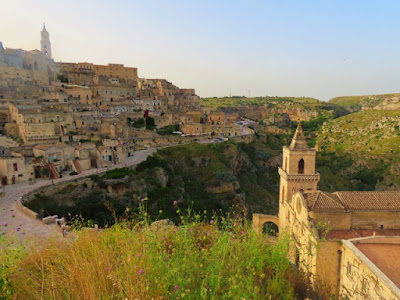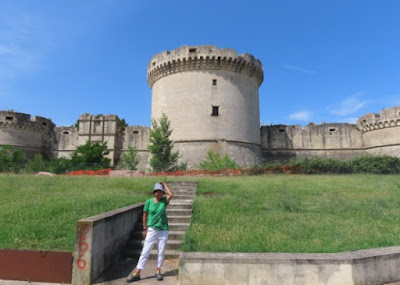
After
two beautiful days in Monopoli and Polignano a Mare, we switched to a totally
different world – Matera, the third oldest city in the world, after Aleppo and
Jericho, with over 10,000 years of history. There isn’t any sea view with
crystal clear water in Matera but rock caves and dwellings. Matera is simply
magical and mystical.
The
symbol of Matera is the “Sassi”, caves dug into the mountain where the local
people lived. One cave dwelling accommodated families and their animals. Life
was harsh with scarce resources. When the population grew bigger, the living
condition further deteriorated. The extreme poverty together with the poor
hygiene and infectious diseases led to isolation. Matera was segregated from
the rest of Italy and named ‘Shame of Italy’.
Until
1950s, due to the deteriorating conditions and escalating health crisis in Sassi
di Matera, the city government authorised to construct modern apartments just
off the ancient Sassi. Many cave houses and original furnishing sat empty for
the next few decades. However, after another generation or two, people of
Matera rediscovered Sassi's historical and spiritual importance. Indigenous
locals began to contemplate the future and preservation of their ancient
heritage.
In
1993, Matera was placed on the UNESCO World Heritage Sites list. Thereafter, considerable money and expertise
flew in from across Italy and the European Union. Sassi di Matera experienced
a remarkable revival. With the arrival of Hollywood, Matera flourishes and
tourism expands tremendously. Boutique hotels and high-end restaurants set
their foot around Matera. They are barely more than twenty years old.
Sassi
di Matera refers to two neighborhoods of stone dwellings: Sasso Caveoso and
Sasso Barisano. Sasso Barisano is more developed of the two, most of the caves
were turned into beautiful boutique hotels, restaurants, cafes and shops. Sasso
Caveoso is less polished and where you can still find many abandoned cave
houses.
We
took a scheduled coach from Polignano a Mare to Matera. The coach stop at
Matera is far away from Sassi. Our accommodation (Sassi) host was very kind to
pick us up. The journey is over 10 minutes. Local bus service is very infrequent.
Taxi is the best alternative for transfer between the coach station and Sassi.
Expect to pay between €10-15.
After
settling down in our charming apartment in the modern part of Matera, we had a
quick look of the key buildings around and headed to one of the best views of
the Sassi which was from the hills across Gravina Ravine. It is accessible through a grueling hike up
and down across the Gravina River. The first sightseeing points is a suspension
bridge at the bottom of the ravine. Continuing forward visitors will see
numerous natural and man-carved caves, rock churches along the hike.
Unfortunately,
the path was blocked due to heavy rains and landslides prior to our visit, June 2023. We could only see the empty Tibet suspension bridge from high up. A big pity! Nevertheless, the walk around to see Matera and the ravine are impressive!
Happily, there are a few other fabulous viewpoints to leave visitors
great impression of the miraculous Matera. Here are some of them:
Belvedere Luigi Guerricchio detto dei “Tre Archi”, next to Matera’s main square, Piazza Vittorio Veneto.
Piazzetta Pascoli of Matera, a romantic balcony offering evocative panoramic views of the Sassi. It is to the left of Palazzo Lanfranchi.
Above Church of San Pietro Barisano – After visiting this rock church in Sasso Barisano, walk up the streets above it for an excellent view.
Piazza San Pietro Caveoso from Via Muro and Via San Giacomo
Belvedere Emilio Colombo Statista
On our second day we purchased a combo pass to visit the three most popular Rupestrian churches, a few museums and a cave dwelling. They are:
- Rock churches (Church of Saint Mary of Idris, Church
of Santa Lucia alle Malve, Church of Saint Peter Barisano)
- Vicinato A Pozzo (Neighbourhood centred on a common well) - to learn about the daily life and social evolvement of Matera through multi-media projection
The Church of Saint Mary of Idris is the most iconic Rupestrian church in Matera. It is built into a giant monolith. The
Church of St. Peter's Caveoso stands quietly on the lower left of this rock church. The two together win admiration from all angles. When standing at either position, one can have magnificent views of the city. The interior of Saint Mary of Idris consists of a single room with frescoes dating between 12th and 17th century. Click
here for more information and the beautiful frescoes.
The Rupestrian church of
Santa Lucia alle Malve is the first female monastic settlement of the Benedictine Order of the 8th century, and the most important in the history of the city of Matera. It is next to Sasso Caveoso. It consists of a main space with high ceiling and two large side chapels. The three spaces have frescoes dating between the Byzantine and Christian era. It is a wonder that the colours remain vivid. Click
here for more details and images.
 |
| https://sassidimatera.net/ |
San Pietro Barisano is the largest rock church in the city of Matera. The first rock formation is possibly dating back to the 12th-13th centuries, below the floor. It is a prime example of Baroque architecture, characterized by its ornate facades and detailed interior decor. The location of Saint Peter Barisano offers stunning views of the surrounding Sassi, especially during the golden hour with the soft light. Click
here for more details and images.
Due to excessive humidity, the parish was moved to the nearby church of Sant’Agostino along with most of the sacred furnishings, including the baptismal font in 1903. Unfortunately, following the abandonment of the Sassi, most of the works of art were stolen or damaged.
Apart from the three Rupestrian churches, there are countless rock churches and normal churches in Matera. The biggest and most popular is the Cathedral with treasures of art. The other important ones include but are not limited to San Pietro Caveoso, San Francesco d’Assisi, Chiesa del Purgatorio, Chiese dei Santi Pietro Paolo. Religion was particularly important in the days of hardship and deprived conditions. Spiritual support was elementary to survival with hope and consolation.
Casa Grotta means a furnished Cave Dwelling carved in a large natural hollow in rock or in the earth. Nowadays, it shows how people lived in these caves in the 18th century and provides an insight into life there. Families lived together with their animals without running water, heat and had poor sanitation.

Visit to Matera is not completed if one does not see
Carlo Levi’s mural
Lucania 61 in the National Museum of Medieval and Modern Art (Palazzo Lanfranchi).
 |
| museoradio3.rai.it |
Levi (1902 – 1975) was an activist / independent leftist politician in parallel to a painter, writer and doctor. Due to his activism and involvement with anti-fascist movements, Levi was arrested and exiled to
Aliano and
Grassano, two towns in Lucania (now Basilicata), where he lived an interior experience in contact with a population abandoned by history, with a very ancient and hidden world, to discover a different civilization. His wrote in his masterpiece, “
Christ stopped in Eboli”, about the inhuman living conditions of people crushed by social injustices and political indifference, poor peasants forgotten and have been bypassed by Christianity, by morality, by history itself - that they have somehow been excluded from the full human experience. One sentence in Christ stopped in Eboli “The air was black with thousands of flies and other thousands covered the wall.” Can you imagine how bad the condition was?

Lucania 61 describes the Lucanian everyday life in biblical technicolour. Scenes are inspired by the photos taken by
Mario Carbone, a close friend accompanied Levi’s exile. The mural represents the life of Levi’s
poet friend Rocco Scotellaro in
three fundamental moments: adolescence in the center, adulthood on the right and his death on the left, surrounded by mourners. Visitors can easily visualise the trauma and desperation in the isolated and forgotten Matera.
The museum is divided into three sections: Sacred Art, Collections and Contemporary Art.
Exhibits are not the works of the most famous painters or artists but as nice. You can see some more of
Levi's paintings.

Another unique visit is definitely the
Palombaro Lungo (Long Palombaro), a giant subterranean cistern under Piazza Vittorio Veneto from the 16th century. The 50 million litre capacity cistern kept the rainwater for Matera for hundreds of years. Its depth and length are 16 and 50 meters. Walking down through the metal walkways is an amazing and exceptional experience. How could this giant be built hundreds of years ago, without powerful and intelligent heavy machines of the present day? Magic!
And, pay attention to the deteriorated frescoes at the entrance to Palombaro Lungo. They are old and beautiful.
One prime but not very well-known visit in Matera is the
MUSMA, Museo della Scultura Contemporanea Matera. It is the only cave museum in the world and the most important Italian museum entirely dedicated to sculpture.
MUSMA illustrates the history of Italian and international sculpture from the end of the 19th century to today with a rich corpus of works: sculptures, ceramics, medals, jewels, drawings, graphic works and artist's books. Its precious collection is exhibited inside
Palazzo Pomarici (16th century), amazing art pieces housed atmospherically in an outstanding setting.
Dotted around the Sassi are numerous statues. I was particularly attracted to those by
Margherita Grasselli. It is not difficult to be impressed by them. They make you smile, wow and fascinated.
Days in Matera are easily filled with the various programmes. If you can spare some time, you may like to visit the 16th century
Tramontano Castle, a bit outside the Sassi. It takes its name from the count to which it belonged. He took the fiefdom of Matera which the population had already paid the ransom to be free. Tired of the taxes that had to be paid for the construction of the castle, a group of men assassinated the count. Therefore, the construction remains unfinished. Today the
Tramontano Castle is undergoing restoration of the moat and walls. It is normally closed except during FAI days. However, one can visit it from the outside and enjoy the adjacent park.
Last but not the least: one must see Matera in the night. When the sun goes down and the lights and street lamps across the Sassi are on, the scenery is enchanting.












































Comments